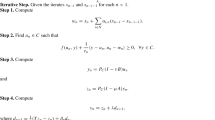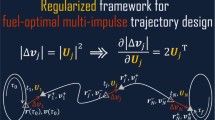Abstract
Optimization problems involving multiple impulsive maneuvers are, in general, nonlinear and nonconvex. This implies that their resolution is prone to local optimality and convergence issues. This work proposes an optimization method to exploit a specific structure of single-constraint nonlinear programming problems. The proposed algorithm is able to transform an optimization problem with an arbitrary number of variables into a root-finding problem of a univariate algebraic equation. Moreover, it can readily overcome the aforementioned local optimality and convergence issues. This methodology has been applied to three practical application examples. The first application involves the inclination optimization for change of plane maneuvers using drifting orbits with a relative nodal precession. The second application performs the semi-major axis optimization of phasing orbits, using a two-stage approach to solve it; specifically, the dual-based method yields a solution with phasing orbits that perform a fractional number of revolutions, which is then corrected to provide the appropriate integrality condition. The third application carries out the optimization of multi-impulse Hohmann-like transfers with an inclination change, relying on a conservation law that allows to compute a multi-impulse transfer from the solution of a two-impulse transfer. Finally, two highly relevant mission scenarios are described and numerically solved: the first scenario considers a geostationary transfer orbit with a phasing optimization to locate a satellite into a prescribed slot in geostationary orbit; the second scenario considers a multi-target rendezvous of a servicing spacecraft to visit several satellites of a constellation for debris removal or refueling operations.





Similar content being viewed by others
References
Bazaraa, M.S., Sherali, H.D., Shetty, C.M.: Nonlinear Programming: Theory and Algorithms. Wiley, Hoboken (2013)
Geoffrion, A.M.: Duality in nonlinear programming: A simplified applications-oriented development. SIAM Rev. 13(1), 1–37 (1971). https://doi.org/10.1137/1013001
Erlenkotter, D.: A dual-based procedure for uncapacitated facility location. Oper. Res. 26(6), 992–1009 (1978). https://doi.org/10.1287/opre.26.6.992
Balakrishnan, A., Magnanti, T.L., Mirchandani, P.: A dual-based algorithm for multi-level network design. Manag. Sci. 40(5), 567–581 (1994). https://doi.org/10.1287/mnsc.40.5.567
Sharma, R., Sharma, K.: A new dual based procedure for the transportation problem. Eur. J. Oper. Res. 122(3), 611–624 (2000). https://doi.org/10.1016/S0377-2217(99)00081-8
Guignard, M., Rosenwein, M.B.: An improved dual based algorithm for the generalized assignment problem. Oper. Res. 37(4), 658–663 (1989). https://doi.org/10.1287/opre.37.4.658
Wang, Y., Zhou, G., Caccetta, L., Liu, W.: An alternative Lagrange-dual based algorithm for sparse signal reconstruction. IEEE Trans. Signal Process. 59(4), 1895–1901 (2010). https://doi.org/10.1109/TSP.2010.2103066
Hoang, T.D., Le, L.B., Le-Ngoc, T.: Energy-efficient resource allocation for d2d communications in cellular networks. IEEE Trans. Vehic. Technol. 65(9), 6972–6986 (2015). https://doi.org/10.1109/TVT.2015.2482388
Maxeiner, L.S., Engell, S.: Comparison of dual based optimization methods for distributed trajectory optimization of coupled semi-batch processes. Optim. Eng. 21(3), 761–802 (2020). https://doi.org/10.1007/s11081-020-09499-7
Brent, R.P.: An algorithm with guaranteed convergence for finding a zero of a function. Comput. J. 14(4), 422–425 (1971). https://doi.org/10.1093/comjnl/14.4.422
Martello, S., Toth, P.: Knapsack Problems: Algorithms and Computer Implementations. Wiley, Hoboken (1990)
Vallado, D.A.: Fundamentals of Astrodynamics and Applications, Space Technology Library, vol. 12. Microcosm Press/Springer, El Segundo (2001)
Chobotov, V.A.: Orbital Mechanics. American Institute of Aeronautics and Astronautics, Reston (2002)
Kechichian, J.A.: Reformulation of Edelbaum’s low-thrust transfer problem using optimal control theory. J. Guid. Control Dyn. 20(5), 988–994 (1997). https://doi.org/10.2514/2.4145
de Bruijn, F.J., Theil, S., Choukroun, D., Gill, E.: Collocation of geostationary satellites using convex optimization. J. Guid. Control Dyn. 39(6), 1303–1313 (2016). https://doi.org/10.2514/1.G001650
Larbi, B., Grzesik, M., Radtke, B. T., Stoll, E.: Active debris removal for mega constellations: CubeSat Possible? In: Proceedings of the 9th International Workshop on Satellite Constellations and Formation Flying IWSCFF2017, Boulder, Colorado (2017)
Forshaw, J., Vos van Steenwijk, R., Wokes, S., Ainley, S., Bradford, A., Auburn, J., Blackerby, C., Okada, N.: Preliminary design of an end-of-life ADR mission for large constellations. In: 70th International Astronautical Congress (IAC), Washington DC, pp. 21–25 (2019)
Huang, S., Colombo, C., Gonzalo Gómez, J., Masserini, A., Nugnes, M., Vallini, L., Petit, M.: Preliminary mission analysis of active debris removal service for large constellations. In: 71st International Astronautical Congress (IAC 2020), pp. 1–6 (2020)
Shen, H., Tsiotras, P.: Peer-to-peer refueling for circular satellite constellations. J. Guid. Control Dyn. 28(6), 1220–1230 (2005). https://doi.org/10.2514/1.9570
Zhang, J., Parks, G.T., Luo, Y.-Z., Tang, G..-j: Multispacecraft refueling optimization considering the J2 perturbation and window constraints. J. Guid. Control Dyn. 37(1), 111–122 (2014). https://doi.org/10.2514/1.61812
Zhao, Z., Zhang, J., Li, H.-Y., Zhou, J.-Y.: LEO cooperative multi-spacecraft refueling mission optimization considering J2 perturbation and target’s surplus propellant constraint. Adv. Space Res. 59(1), 252–262 (2017). https://doi.org/10.1016/j.asr.2016.10.005
CelesTrack: Two Line Element set for Starlink constellation. https://celestrak.com/NORAD/elements/starlink.txt. Accessed 21 Jan 2022 (2022)
Acknowledgements
AB and HU wish to acknowledge funding from Grant PID2020-112576GB-C22 of the Spanish State Research Agency and the European Regional Development Fund. AB also wishes to acknowledge funding from Grant PREDOC20-003 of “Universidad Rey Juan Carlos”. LC wishes to acknowledge support from Project Grant F663—AAGNCS by the “Dirección General de Investigación e Innovación Tecnológica, Consejería de Ciencia, Universidades e Innovación, Comunidad de Madrid” and “Universidad Rey Juan Carlos”.
Author information
Authors and Affiliations
Corresponding author
Ethics declarations
Conflict of interest
The authors declare that they have no conflict of interest.
Rights and permissions
Springer Nature or its licensor (e.g. a society or other partner) holds exclusive rights to this article under a publishing agreement with the author(s) or other rightsholder(s); author self-archiving of the accepted manuscript version of this article is solely governed by the terms of such publishing agreement and applicable law.
About this article
Cite this article
Barea, A., Urrutxua, H. & Cadarso, L. Dual-Based Method for Global Optimization of Impulsive Orbital Maneuvers. J Astronaut Sci 69, 1666–1690 (2022). https://doi.org/10.1007/s40295-022-00357-5
Accepted:
Published:
Issue Date:
DOI: https://doi.org/10.1007/s40295-022-00357-5




